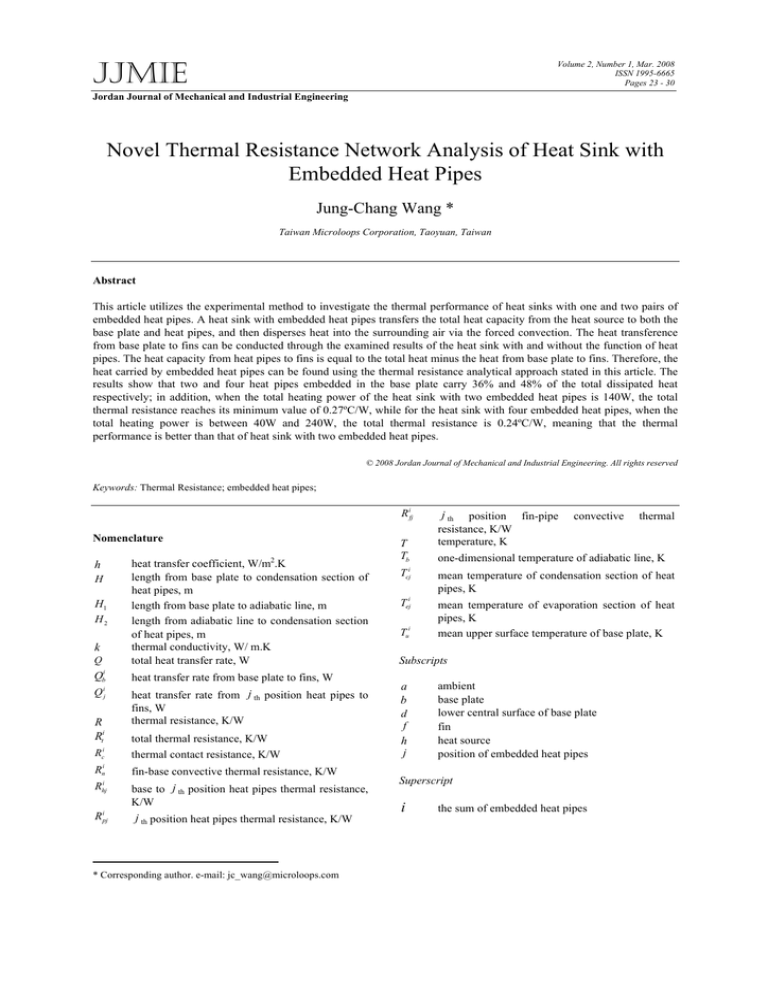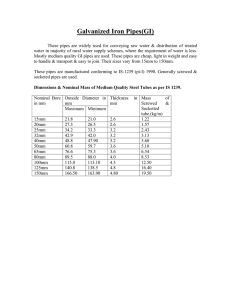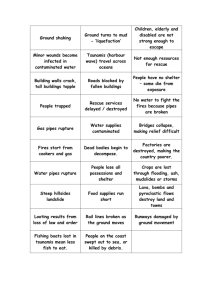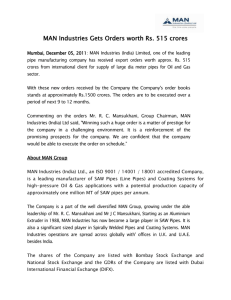
JJMIE
Volume 2, Number 1, Mar. 2008
ISSN 1995-6665
Pages 23 - 30
Jordan Journal of Mechanical and Industrial Engineering
Novel Thermal Resistance Network Analysis of Heat Sink with
Embedded Heat Pipes
Jung-Chang Wang *
Taiwan Microloops Corporation, Taoyuan, Taiwan
Abstract
This article utilizes the experimental method to investigate the thermal performance of heat sinks with one and two pairs of
embedded heat pipes. A heat sink with embedded heat pipes transfers the total heat capacity from the heat source to both the
base plate and heat pipes, and then disperses heat into the surrounding air via the forced convection. The heat transference
from base plate to fins can be conducted through the examined results of the heat sink with and without the function of heat
pipes. The heat capacity from heat pipes to fins is equal to the total heat minus the heat from base plate to fins. Therefore, the
heat carried by embedded heat pipes can be found using the thermal resistance analytical approach stated in this article. The
results show that two and four heat pipes embedded in the base plate carry 36% and 48% of the total dissipated heat
respectively; in addition, when the total heating power of the heat sink with two embedded heat pipes is 140W, the total
thermal resistance reaches its minimum value of 0.27ºC/W, while for the heat sink with four embedded heat pipes, when the
total heating power is between 40W and 240W, the total thermal resistance is 0.24ºC/W, meaning that the thermal
performance is better than that of heat sink with two embedded heat pipes.
© 2008 Jordan Journal of Mechanical and Industrial Engineering. All rights reserved
Keywords: Thermal Resistance; embedded heat pipes;
R ifj
Nomenclature
Q
heat transfer coefficient, W/m2.K
length from base plate to condensation section of
heat pipes, m
length from base plate to adiabatic line, m
length from adiabatic line to condensation section
of heat pipes, m
thermal conductivity, W/ m.K
total heat transfer rate, W
Qbi
heat transfer rate from base plate to fins, W
Q ij
heat transfer rate from j th position heat pipes to
fins, W
thermal resistance, K/W
h
H
H1
H2
k
R
Rti
total thermal resistance, K/W
Rci
thermal contact resistance, K/W
Rni
fin-base convective thermal resistance, K/W
Rhji
base to j th position heat pipes thermal resistance,
K/W
R ipj
j th position heat pipes thermal resistance, K/W
* Corresponding author. e-mail: jc_wang@microloops.com
T
Tb
i
cj
j th position fin-pipe
resistance, K/W
temperature, K
convective
thermal
one-dimensional temperature of adiabatic line, K
T
mean temperature of condensation section of heat
pipes, K
Teji
mean temperature of evaporation section of heat
pipes, K
mean upper surface temperature of base plate, K
Tui
Subscripts
a
b
d
f
h
j
ambient
base plate
lower central surface of base plate
fin
heat source
position of embedded heat pipes
Superscript
i
the sum of embedded heat pipes
24
© 2008 Jordan Journal of Mechanical and Industrial Engineering. All rights reserved - Volume 2, Number 1 (ISSN 1995-6665)
1. Introduction
Since 1971, when the Intel Corporation launched the
first chip(with 10μm wires and 2300 transistors), the
number of transistors in a chip has increased to over ten
million. This means that an equivalent surface area of chip
produces far greater heat than previously, leading to an
increase in critical heat flux speed. The maximum limited
temperature that can be borne by silicon chip in electronic
components is 120ºC, with a normal operating temperature
of under 70ºC. The reliability of electronic components
drops by 10% for each increase of 2ºC in normal operating
temperature[1], and high temperature is a major reason for
the malfunctioning or shortening of life of electronic
components. Thus, it is necessary to quickly remove high
heat generated by electronic components for a normal
operating temperature of under 70ºC.
In the past, the method used for solving the high heat
capacity of electronic components has been to install a
heat sink with a fan directly on the heat source, removing
the heat through forced convection. Webb[2] pointed out
that it is necessary to increase the fin surface and fan speed
of the direct heat removal heat sink in order to solve the
ever-increasing high heat flux generated by CPUs. The
total thermal resistance is used to evaluate the thermal
performance of a heat sink. Duan and Muzychka[3]
increased the heat dispersing surface area of the heat sink
fins, reducing the total thermal resistance from 0.55 oC/W
to 0.35 oC/W. Lin et al.[4] boosted the fan speed to obtain
an optimum total thermal resistance value of 0.33 oC/W at
a maximum speed of 4000rpm. However, increasing the
surface area results in an increase in cost and boosting the
fan speed results in noise, vibration and more power
consumption, which increase the probability of failure to
electronic components.
In a heat sink with embedded heat pipes, the use of heat
pipes to rapidly transfer heat from the heat source to the
fins, without increasing the surface area of the fins or
increasing the speed of the fan, makes it possible to reduce
the total thermal resistance to under 0.3ºC/W. Due to high
thermal conductivity of the heat pipes, the thermal
resistance is very low at about 10-1~10-3 oC/W[5-7]. Xie
et al.[8] conducted an experiment combining a 4mm
diameter heat pipe and a heat sink, achieving an optimum
total thermal resistance of 0.29 oC/W. Legierski and
Wiecek [9] pointed out that the thermal performance of the
heat sink with embedded heat pipes is better than that of an
ordinary heat sink, with an optimum total thermal
resistance value of 0.25 oC/W. Gernert et al.[10] used a
heat sink with embedded heat pipes composed of a
25.4mm diameter heat pipe and an aluminum heat sink;
when the maximum heat flux was 285W/cm2, the
minimum total thermal resistance value was 0.225ºC/W.
Wang et al.[11] examined two horizontal embedded heat
pipes of diameter 6mm inserted into base plate and fins in
order to take heat capacity from heat source. From the
results, the ratio of total heat capacity of embedded heat
pipes is 36%. Therefore, a heat sink with embedded heat
pipes is one of the best solutions for thermal problems of
high heat generation in electronic components.
The heat sink with one and two pairs of embedded heat
pipes studied in this article is shown in Fig.1(a) and
Fig.1(b), respectively. The dimensions of the heat sink are
75 x 70 x 43 mm3. The ends of heat pipes are inserted into
the base plate as the evaporation section, and the other
ends are embedded into the fins as the condensation
section. Because the heat pipes are embedded into the left
and right sides of the base plate in a parallel manner, and
the heat source is placed directly onto the center of the
base plate; therefore, the heat pipes bear equal heat from
the heat source. Previous research only measures the
contact, base plate and total thermal resistances of a heat
sink with embedded heat pipes, without addressing the
proportion of the total heat carried away via the heat pipes.
In light of this, this study utilized experimental methods
incorporating superposition method to calculate the heat
carried to the fins through the base plate and embedded
heat pipes, in order to find the ratio of total heat transferred
through the heat pipes. These individual thermal
resistances of contact, base plate, base to heat pipes, heat
pipes, fins and the total thermal resistance can be obtained
through thermal resistance analysis.
Figure 1: (a) Heat sink with one pair of embedded heat pipes, (b)
Heat sink with two pairs of embedded heat pipes
2. Thermal Resistance Network
This paper use the superposition method for the heat
sink with embedded heat pipes as shown in Fig. 2. The
symbols i and j respectively denote the number and
position of the embedded heat pipes. The total heating
power Q is transferred from the heat source to the base
i
plate and the heat pipes. The heating power Qb is borne
away by the base plate; the heat pipes are the adiabatic
i
boundary conditions, and Qb is transferred upward to the
fins.
© 2008 Jordan Journal of Mechanical and Industrial Engineering. All rights reserved - Volume 2, Number 1 (ISSN 1995-6665)
25
Figure 2: Superposition method of heat sink with embedded heat pipes
(b)
(a)
Figure 3: (a) Heat sink with embedded heat pipes heat flow pathways, (b) Fin temperature distribution
i
The heating power Q j is carried away through the heat
pipes laid in a parallel fashion to the left and right of the
heat source; the base plate is the adiabatic boundary
i
condition, and Q j is transferred downward to the fins.
i
i
Consequently, Q equals the sum of Qb and Q j from the
superposition method. Because of measuring the thermal
performance by separately testing the heat sink with and
i
without the function of heat pipes, Qb can be found from
comparing
the
same
temperature
differences
i
corresponding to the input heating power. Then Q j equals
i
to Q minus Qb .
shows temperature distribution graph for the surface of the
i
fins, where Tb is adiabatic temperature, Tcj is the
temperature of the condensation section of the heat pipes,
i
and Tu is the temperature of the upper surface of the base
plate. Assuming these temperatures are uniform both on
the upper surface of the base plate and on the condensation
section of the heat pipes, the steady one-dimensional
energy balance equation for fins is[12]
i
i
Assuming that Qb and Q j transfer heat as onedimension steady heat flow model, and Q is divided into
i
i
two pathways transferring heat from Qb upward and Q j
downward to the fins as shown in Fig. 3(a). The region
where temperature gradient equals to zero appearing
between these two heat transfer pathways is called
adiabatic line. The fins in this adiabatic position will not
have heat transfer. The distance from the upper surface of
the base plate to the condensation section of the heat pipes
is H , and those from the adiabatic position to the upper
surface of the base plate and to the condensation section of
the heat pipes are H1 and H 2 respectively. Figure 3(b)
and
d 2T i
dY
m=
2
(
)
− m2 T i − Tai = 0
(1)
2h
k jt f
(2)
where h represents the convective heat transfer
coefficient, k f is the fin conductivity , t f is the fin
i
thickness and Ta is the ambient temperature. The specified
boundary conditions can be expressed as
i
i
T i = Tui at Y = 0 and T = Tcj at Y = H
(3)
26
© 2008 Jordan Journal of Mechanical and Industrial Engineering. All rights reserved - Volume 2, Number 1 (ISSN 1995-6665)
The temperature profile for the fins can be obtained
from Eq.(1) as
⎡ (Tui −T ai ) e mH
(Tcji −Tai )
− mH
T i (Y ) = T ai + ⎢ mH
− mH
e − e − mH
⎢⎣ e − e
⎡ (T −T ) (T −T ) e
+ ⎢ mH
− mH
− mH
e − e − mH
⎢⎣ e − e
i
cj
i
a
i
u
− mH
i
a
sum of the thermal contact resistance Rci and the thermal
i
resistances on the pathways of Qbi and Q j , which is
⎤
⎥ e − mY
⎥⎦
⎤
⎥ e mY
⎥⎦
The total thermal resistance Rti can be expressed as the
1
Rti = Rci +
(4)
i 2
(R
i
b
1
1
+∑ i
i
i
+ Rni
j =1 Rhj + R pj + R fj
)
(
(7)
)
i
In Eq. (7), Rt is defined as the temperature difference
From the definition of adiabatic line,
(the temperature of heat source Thi minus the ambient
i
∂T
= 0 at Y = H 1
∂Y
(5)
The location of adiabatic line can be shown as
⎡ (Tui − Tai ) e mH − (Tcji − Tai )
1
H1 =
ln ⎢ i
2m ⎢ (Tcj − Tai ) − (Tui − Tai ) e − mH
⎣
defined as the temperature difference ( Tdi minus the
⎤
⎥
⎥⎦
(6)
resistance Rn2 in the Qb2 pathway, and base to heat pipes
resistance R , heat pipes resistance R
average temperature at upper surface of the base plate Tui )
divided by Qbi . Rni is defined as the temperature difference
Figure 4 shows an analysis of the thermal resistance
network of the heat sink with embedded heat pipes. When
the superscript i equals 2 or 4, it represents, respectively,
that the heat sink has a total of two or four embedded heat
pipes. The heat sink with two embedded heat pipes has
2
base plate thermal resistance Rb and fin-base convective
2
h1
i
temperature Tai ) divided by total heating power Q . Rc is
defined as the effective temperature difference at the
i
interface ( Th minus the temperature at the center of the
i
lower surface of the base plate Td ) divided by Q . Rbi is
2
p1
and fin-pipe
i
( Tui minus Tai ) divided by Qbi . Rhj is defined as the
temperature difference ( Tdi minus the temperature of
i
i
i
evaporation section of heat pipes Tej ) divided by Q j . R pj
i
is defined as the temperature difference ( Tej minus the
i
temperature of condensation section of heat pipes Tcj )
i
i
divided by Q j . R fj
is defined as the temperature
i
difference ( T minus T ) divided by Q j .
i
cj
i
a
2
convective resistance R f 1 in the Q12 pathway when i
equals to 2. When i is 4, the heat sink with four embedded
heat pipes has a base plate thermal resistance Rb4 , fin-base
convective resistance Rn4 in the Qb4 pathway, base to inner
4
heat pipes resistance R , inner heat pipes resistance R p1 ,
4
h1
4
inner fin-pipe convective resistance R f 1 , base to outer heat
4
pipes resistance Rh42 , outer heat pipes resistance R p 2 and
4
outer fin-pipe resistance R f 2 in Q14 and Q24 pathway,
respectively.
Figure 4: Thermal resistance analysis network
3. Experimental Investigation
The experimental methods stated in this paper are
mainly aimed at testing the thermal performance of the
heat sink with embedded heat pipes as shown in Fig. 5.
The heat pipes are bending pipes with a diameter 6 mm
and a total length 170 mm. The length of evaporation
section and condensation section is 65 mm respectively,
and the insulated length is 40 mm. The materials of heat
pipe’s container and wick type are copper metal and
sintered structure of pure copper powder respectively.
According to the superposition method for the heat sink
with embedded heat pipes, the first step is to measure the
entire thermal performance of the heat sink with embedded
heat pipes, then measure that of the heat sink with losing
the function of embedded heat pipes at positions where j
is equal to 1,2… i / 2 , successively. The heat capacity
transference from the base plate and the heat pipes to the
fins can be obtained by comparing the individual results in
the same temperature differences respectively.
The experimental test includes the experiments of heat
sinks with two and four embedded heat pipes respectively.
The upper surface of the dummy heater is coated with
thermal grease to reduce contact resistance.
© 2008 Jordan Journal of Mechanical and Industrial Engineering. All rights reserved - Volume 2, Number 1 (ISSN 1995-6665)
27
Figure 5: Experimental apparatus for Heat sink with embedded heat pipes
of the base plate ( Tui ). Computational Fluid Dynamic
commercial software (Icepak) is used to calculate the
average temperature of Tui , which is compared with the
experimental measurement of five-point average value and
develops a correlation between them within an error of
±3%. A fan is placed on the top of heat sink to disperse
heat through forced convection. A thermocouple is placed
on the top of the fan to measure the ambient temperature
( Tai ). Thermocouples are attached to the evaporation and
condensation sections of heat pipes to measure the
i
i
temperatures of Tej and Tcj . This experiment starts with a
heating power of 40W and increases it up to 240W by
increments of 20W.
After separately testing the full thermal performance of
the above two experiments for the heat sink with function
of embedded heat pipes, let all heat pipes in the heat sink
with two embedded heat pipes fail to function ,and allow
the inner( j = 1)and outer( j = 2)heat pipes in the
heat sink with four embedded heat pipes to fail to function
successively. The heat sink experiments without the
function of heat pipes are then performed, and the
corresponding thermal resistances can be determined.
The thermocouples used in the experiment have a
measurement error of ± 0.5 ºC. The cooling circulator
manufactured by Firstek Scientific Co., Ltd., has a
measurement error of ± 0.5 ºC. The data recorder
manufactured by Yokogawa Co., Ltd., has a measurement
error of ±1 %. The power supply unit has a measurement
error of ±0.5 %. The maximum error for the thermal
resistance is within ±5 %.
4. Results and Discussions
Figure 6 shows the experimental results of thermal
performance lines for a heat sink with and without the
function of two embedded heat pipes. As the heating
power is increasing, the temperature difference ( Tu2 − Ta2 )
between the upper surface of the base plate and the
surrounding air also increases whether with or without the
function of two heat pipes. The slopes of these two lines
represent the thermal resistances. Because the slope of the
upper line is greater than that of the lower, the thermal
resistance without function of heat pipes is greater than
that with function of two heat pipes. It means that the
temperature difference ( Tu2 − Ta2 ) is higher without the
function of two heat pipes than that with the function of
two heat pipes.
40
T VS. Q
With Heat Pipes
No Heat Pipes
35
30
25
T =T 2u - T 2a
A T-type thermocouple is attached to the upper surface
of the dummy heater to measure the temperature ( Thi ). Six
thermocouples are attached to the center of the lower
surface of base plate and five points along the diagonal of
the upper surface of base plate, measuring the
temperatures at the center of the lower surface of the base
plate ( Tdi ) and the average temperature of the upper surface
20
Q
15
10
5
Q 2b
Q 21
0
0
20
40
60
80
100 120 140 160 180 200 220 240 260 280
Q (W)
Figure 6: Performance curve for two embedded heat pipes under
various heating power
This is because having an extra path transfers heat from
heat pipes to surrounding and thus reduces the temperature
difference. As the temperature difference for the two lines
is fixed as shown in Fig.6, it reaches the thermal
performance lines with two points at the power input with
and without function of two heat pipes. The corresponding
2
heating power represents the Qb in the heat sink without
the function of two heat pipes and the total Q with the
2
function of two heat pipes. The heat transfer rate Q1 is
equal to the total Q minus the Qb2 . As indicated in Fig.6,
the temperature difference is 15.2ºC, the heating power for
2
Q is 160W, and the power for Qb is 102.6W. Therefore
Q12 equals 57.4W. Table 1 shows the ratio of bypass
2
heating power to total heating power. The ratio (Qb / Q ) is
2
64% and the ratio (Q1 / Q) is 36%.
28
© 2008 Jordan Journal of Mechanical and Industrial Engineering. All rights reserved - Volume 2, Number 1 (ISSN 1995-6665)
Qb2 / Q
Qb2
Q12 / Q
Q12
(W)
40
(%)
67
(W)
26.9
(%)
33
(W)
13.1
60
67
40
33
20
80
64
51.4
36
28.6
100
65
65
35
35
120
63
76
37
44
140
63
88.6
37
51.4
160
64
102.6
36
57.4
180
64
116
36
64
200
65
129.5
35
70.5
220
66
146
34
74
240
66
157.4
34
82.6
Figure 7 shows the experimental results of thermal
performance lines for a heat sink with and without the
function of four embedded heat pipes. As is the case in
Fig.6, the temperature difference of heat sink without
function of embedded heat pipes is the same in the heat
sink with embedded heat pipes, which is fixed the
temperature difference of three curves in the Fig.7. The
corresponding heat transference rate is equal to Qb4 . Let
the temperature difference of the inner embedded heat
pipes be the same in the heat sink with four embedded heat
pipes: Q14 is equal to the corresponding heat transferring
Qb4 ,
Qb4
Q24
rate minus
and
is equal to Q minus
adding
4
Q1 . As indicated in Fig.7, the temperature difference is
14.8ºC, the heating power for Q is 200W, the power for
Qb4 is 104.4W, the power for Q14 is 53.9W, and the power
4
for Q2 is 41.7W. Table 2 shows the ratio of bypass heating
4
power to total heating power. The ratio (Qb / Q ) is 52%,
4
4
the ratio (Q1 / Q) is 27%, and the ratio (Q2 / Q) is 21%.
Table 2. Ratio of bypass heating power to total heating power of
heat sink with four embedded heat pipes
Q
(W)
Qb4 / Q
Qb4
Q14 / Q
Q14
Q24 / Q
Q24
(W)
11
(%)
21
(W)
8.2
40
(%)
52
(W)
20.8
(%)
27
60
52
31.2
27
16.5
21
12.3
80
50
39.9
29
23.1
21
17
100
51
50.6
27
27.2
22
22.2
120
51
61.4
27
32.5
22
26.1
140
52
72.1
27
37.9
21
30
160
52
82.9
27
43.2
21
33.9
180
52
93.6
27
48.5
21
37.9
200
52
104.4
27
53.9
21
41.7
220
52
114.2
27
60.2
21
45.6
240
52
125.6
27
64.9
21
49.5
Figure 8 indicates the relationships of the base plate
resistance Rbi and the fin-base convective resistance Rni
toward the heating power
Qbi .
157.4 W. Rb4 and Rn4 are approximately 0.28ºC/W and
0.14ºC/W respectively when Qb4 is between 20.8 and
125.6 W. They do not change as heating power increases.
i
Thus, Rb and Rni in this experiment can be considered
constants.
40
T VS. Q
With four pipes
With two pipes
No heat pipes
35
30
25
T =T 4u-T 4a
Q
0.15ºC/W respectively when Qb2 is between 26.9 and
20
Q
15
10
5
Q 4b
Q 41
0
20
40
60
80
100 120 140 160 180 200 220 240 260 280
Q (W)
Figure 7: Performance curve for four embedded heat pipe under
various heating power
The reason is that the components transferring heat
through this path of heating power Qbi transferred from the
base plate without function of heat pipes to the fins are all
solid. The thermal physical properties of these components
are the same when there is not much change in
i
i
temperature. Thus Rb and Rni should remain constant. Rb
and Rni obtained in this experiment are both constant,
corroborating the correctness of the experimental results.
The experimental results of Rb4 is larger than that of Rb2 ,
resulting from the distortion effect of heat sink with four
embedded heat pipes larger than that of heat sink with two
embedded heat pipes. From above-mentioned experimental
i
results, Rb increases and Rni decreases as i increases.
0.5
i
R vs Q b
R 2b (2hps)
0.45
R 2n (2hps)
0.4
R 4b (4hps)
4
R n (4hps)
0.35
0.3
0.25
0.2
0.15
0.1
0.05
0
0
20
40
60
in Fig.8. Rb2 and Rn2 are approximately 0.25ºC/W and
80
100
120
140
160
180
Q ib ( W )
These thermal resistance
curves on the paths Qbi are a horizontal trend line as shown
Q 42
0
R ( °C / W )
Table 1. Ratio of bypass heating power to total heating power of
heat sink with two embedded heat pipes
i
Figure 8: Relationships of base plate resistance Rb and fin-base
i
i
convective resistance Rn with the heating power Qb
© 2008 Jordan Journal of Mechanical and Industrial Engineering. All rights reserved - Volume 2, Number 1 (ISSN 1995-6665)
i
Figure 9 indicates the base to heat pipes resistance Rhj ,
heat pipes resistance
R ipj
and fin-pipe convective
i
i
resistance R fj with heating power Q j . Rh21 drops from
0.43ºC/W to 0.33ºC/W under heating power of 13W to
40W. When Q12 is 51.8W, it reaches a minimum value of
0.32ºC/W. Rh21 rises from 0.33ºC/W to 0.39ºC/W under
heating power of 57.6W to 82.6W. Rh41 drops from
0.38ºC/W to 0.35ºC/W under heating power of 11W to
27.2W. When Q14 is 37.9 W, it reaches a minimum value
of 0.34ºC/W. Rh41 rises from 0.36ºC/W to 0.41ºC/W under
heating power of 43.2W to 64.9W. Rh42 drops from
0.58ºC/W to 0.53ºC/W under heating power of 8.2W to
22.2W. When Q24 is 30 W, it reaches a minimum value of
0.52ºC/W. Rh42 rises from 0.58ºC/W to 0.61ºC/W under
heating power of 37.8W to 49.6W.
R ( °C / W )
0.8
i
R vs Q j
0.75
R 2 (2hps)
h1
R 4 (4hps)
h1
0.7
R 2 (2hps)
p1
R 4p1 (4hps)
0.65
R 2 (2hps)
f1
R 4 (4hps)
f1
0.6
R 4 (4hps)
h2
0.55
R 4p2 (4hps)
0.5
R 4f2 (4hps)
0.45
0.4
0.35
29
4
value of 0.10ºC/W when Q24 is 30W. The R p 2 rises from
0.12ºC/W to 0.15ºC/W when Q24 is between 37.8W and
49.6W. They change as the heating power changes.
Figure 10 shows the relationships of the total thermal
resistance and thermal contact resistance to the total
heating power Q . The contact thermal resistance is
approximately 0.03ºC/W when the heating power is
between 40W and 240W. Therefore the contact thermal
resistance in this experiment can be seen as a constant. The
total thermal resistance Rt2 drops from 0.32ºC/W to
0.27ºC/W when the heating power is between 40W to
140W and reaches its minimum of 0.27 ºC/W at 140W.
Rt2 rises from 0.27ºC/W to 0.29ºC/W under 140W to
240W. This is because of the heating power increasing to
the point that the embedded heat pipes are starting to
function, and the total thermal resistance shows a
decreasing trend. The heat pipes are unable to bear
excessive higher heat at heating powers of above 240W,
causing the evaporation section to produce more amounts
of vapor than that of condensed liquid, resulting in the heat
pipes losing performance, thereby increasing total thermal
resistance. The total thermal resistance Rt4 is 0.24 ºC/W
when the heating power is 40 to 240 W and does not
change much as the heating power increases. This is
because the four embedded heat pipes carry away 48% of
the total heat, and the two outer heat pipes can share the
load of the two inner heat pipes load, not causing Rt4 to
increase.
0.3
0.5
0.25
R vs Q
2
R t (2hps)
0.2
0.45
4
0.15
R t (4hps)
0.1
R 2c (2hps)
0.4
R 4c (4hps)
0.05
0.35
0
10
20
30
40
50
60
70
80
90
100
Q ij ( W )
i
Figure 9: Relationships of the base to heat pipes resistance Rhj ,
i
heat pipes resistance R pj and fin-pipe convective resistance
R ifj
with heating power Q i
j
R ( °C / W )
0
0.3
0.25
0.2
0.15
i
The fin-pipe convective resistance R fj do not change
much as the heating power increases, so they can be
considered a constant in this experiment. When the Q12 is
2
4
13W to 82.6W, R f 1 is approximately 0.20ºC/W. R f 1 is
R 4f 2
approximately 0.28ºC/W while Q14 is 11W to 64.9W.
is approximately 0.34ºC/W when the Q24 is 8.2W to
2
49.6W. R p1 drops from 0.20ºC/W to 0.13ºC/W when Q12
is between 13W and 44W. It reaches its minimum value of
2
0.12ºC/W when Q12 is 51.8W. R p1 rises from 0.15ºC/W to
0.21ºC/W when Q12 is between 57.6W and 82.6W. The
Rp41 drops from 0.15ºC/W to 0.12ºC/W when Q14 is
between 11W and 32.5W. It reaches its minimum value of
4
0.11ºC/W when Q14 is 37.9W. The Rp1 rises from
4
0.12ºC/W to 0.15ºC/W when Q1 is between 43.2W and
4
64.9W. The R p 2 drops from 0.16ºC/W to 0.11ºC/W when
Q24 is between 8.2W and 22.2W. It reaches its minimum
0.1
0.05
0
0
20
40
60
80
100 120 140 160 180 200 220 240 260 280
Q(W)
Figure 10: Relationships of the total thermal resistance and
thermal contact resistance with heating power Q
Figure 11 indicates the temperature of heat source with
total heat transference rate Q . The temperature of heat
source Thi of heat sink with two( i = 2)and four ( i =
4)embedded
heat
pipes
can
be
calculated
by
Eq.(8)and Eq.(9)at heating power 40W to 240W
respectively. When the Thi is 70ºC, the corresponding
heating power Q of the heat sink with two and four
embedded heat pipes is 131W and 164W individually.
This means that the temperature of heat sink with four
embedded heat pipes rises more slowly than that of two
embedded heat pipes in the same heating power. The
reason is that outer heat pipes of the heat sink with four
30
© 2008 Jordan Journal of Mechanical and Industrial Engineering. All rights reserved - Volume 2, Number 1 (ISSN 1995-6665)
embedded heat pipes can bear and carry away an
additional 33W of heat capacity from the heat source when
the Thi is 70º. Furthermore, with respect to CPUs that emit
high heat flux, a heat sink with four embedded heat pipes
is able to carry away heat capacity faster than a heat sink
with two embedded heat pipes, thereby attaining a lower
CPU operating temperature.
Th2 = 0.30 × Q + 30.6
(8)
Th4 = 0.24 × Q + 30.6
(9)
120
i
T h vs Q
110
2
T h (2hps)
T 4h (4hps)
100
Eq.(8)
Eq.(9)
90
T ih ( °C )
80
70°C
70
60
50
40
131 W
30
164 W
20
10
0
0
20
40
60
80
100 120 140 160 180 200 220 240 260 280
Q(W)
Figure 11: Relationships of the temperature of heat source with
total heat transferring rate Q
5. Conclusions
Through these experiments in this study, it has been
2
found that heat transfer rate Q12 and Qb of heat sink with
two embedded heat pipes occupy 36% and 64% of the total
Q respectively, and Q24 , Q14 and Qb4 of the heat sink with
four embedded heat pipes account for 21%, 27% and 52%
of the total Q individually. Moreover, the total thermal
resistance of the heat sink with two embedded heat pipes is
only affected by changes in the base to heat pipes thermal
resistance and heat pipes thermal resistance over the heat
flow path of the Q12 ; that is, the total thermal resistance
varies according to the functionality of the heat pipes. As
for the total thermal resistance of heat sink with four
embedded heat pipes, at 40W to 240W, the two outer heat
pipes can carry away more heat, so the total thermal
resistance is a constant. If the temperature of the heat
source is not allowed to exceed 70º, the total heating
powers of heat sink with two and four embedded heat
pipes will not exceed 131W and 164W respectively.
Finally, the superposition principal analytical method for
the thermal performance of the heat sink with embedded
heat pipes is completely established in the present paper.
References
[1] Bar-Cohen, A. D. Kraus, and S. F. Davidson, “Thermal
frontiers in the design and packaging microelectronic
equipment”. Mechanical Engineering, Vol. 105, No. 6, 1983,
53-59.
[2] Ralph L. Webb, “Next Generation Devices for Electronic
Cooling with Heat Rejection to Air". ASME J. Heat Transfer,
Vol.127, 2005, 2-10.
[3] Zhipeng Duan, and Yuri S. Muzychka, “Impingement air
cooled plate fin heat sinks Part II- Thermal resistance
model". IEEE Inter Society Conference on Thermal
Phenomena, 2004.
[4] S. C. Lin, F. S. Chuang, and C. A. Chou, “Experimental
study of the heat sink assembly with oblique straight fins".
Experimental Thermal and Fluid Science, Vol. 29, 2005,
591–600.
[5] G.. P. Peterson. An introduction to heat pipe-modeling,
testing, and applications. New York: John Wiley & Sons
Inc.; 1994.
[6] Taxiong Wang, and G. P. Peterson, “Investigation of a Novel
Flat Heat Pipe". ASME J. Heat Transfer, Vol. 127, 2005,
165-170.
[7] Faghri, Heat Pipe Science and Technology, Taylor and
Francis Ltd., 1995.
[8] H. Xie, A. Ali, and R. Bhatia, “The use of heat pipes in
personal computers". Inter Society Conference on Thermal
Phenomena, 1998.
[9] Jaroslaw Legierski, and Boguslaw Wiecek, “Steady state
analysis of cooling electronic circuits using heat pipes".
IEEE Transactions on Components and Packing
Technologies, Vol.24, No.4, 2001, 549-553.
[10] N. J. Gernert, J. Toth, and J. Hartenstine, “100 W/cm2 and
higher heat flux dissipation using heat pipes”. 13th
International Heat Pipe Conference, 2004.
[11] J.C. Wang, H.S. Huang, and S.L. Chen, “Experimental
investigations of thermal resistance of a heat sink with
horizontal embedded heat pipes". International
Communications in Heat and Mass Transfer, Vol. 34, 2007,
958-970.
[12] W. M. Rohsenow, J. P. Hartnett, and Y. I. Cho. Handbook of
heat transfer .3 rd ed. McGraw-Hill; 1998.






